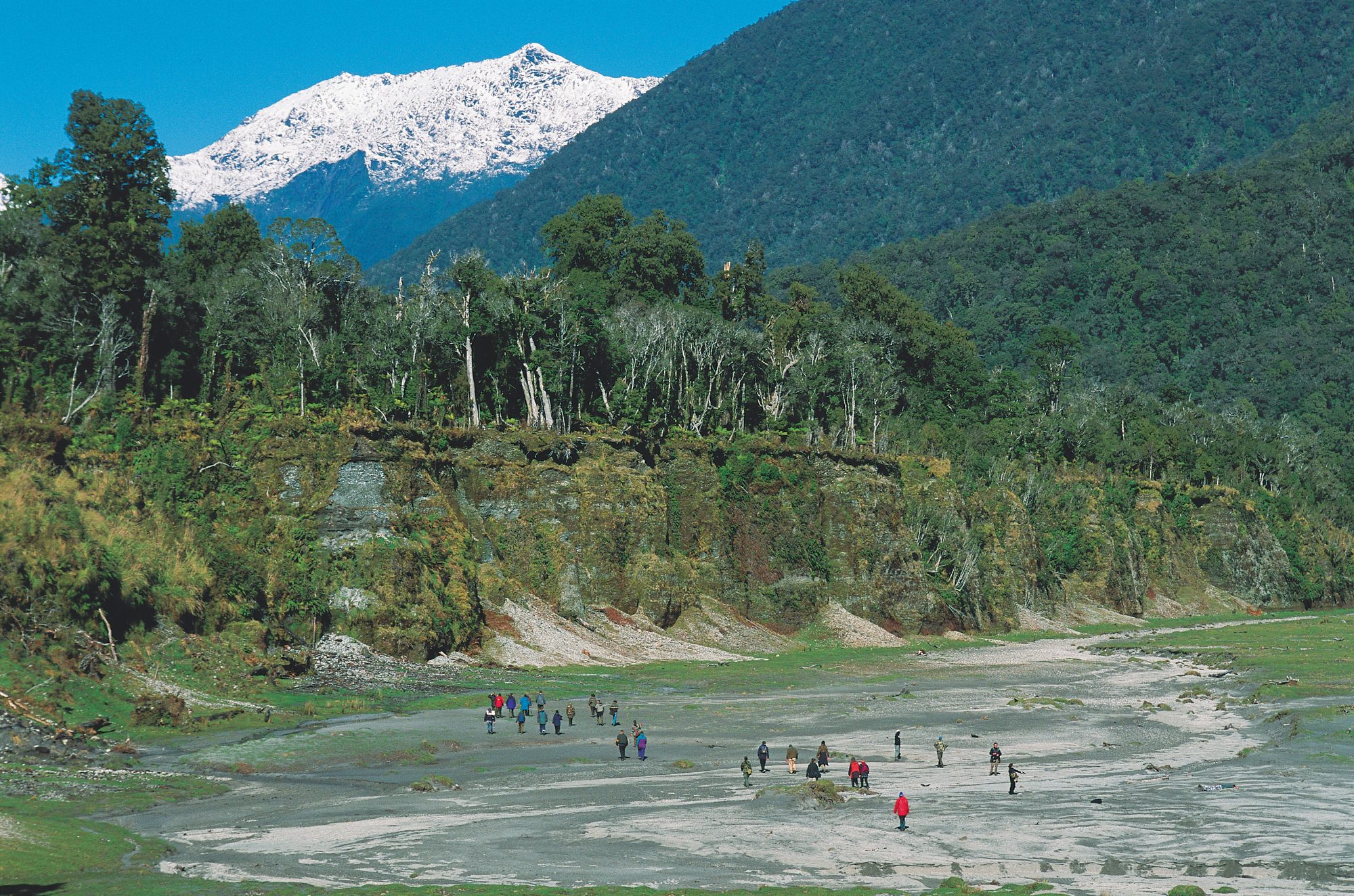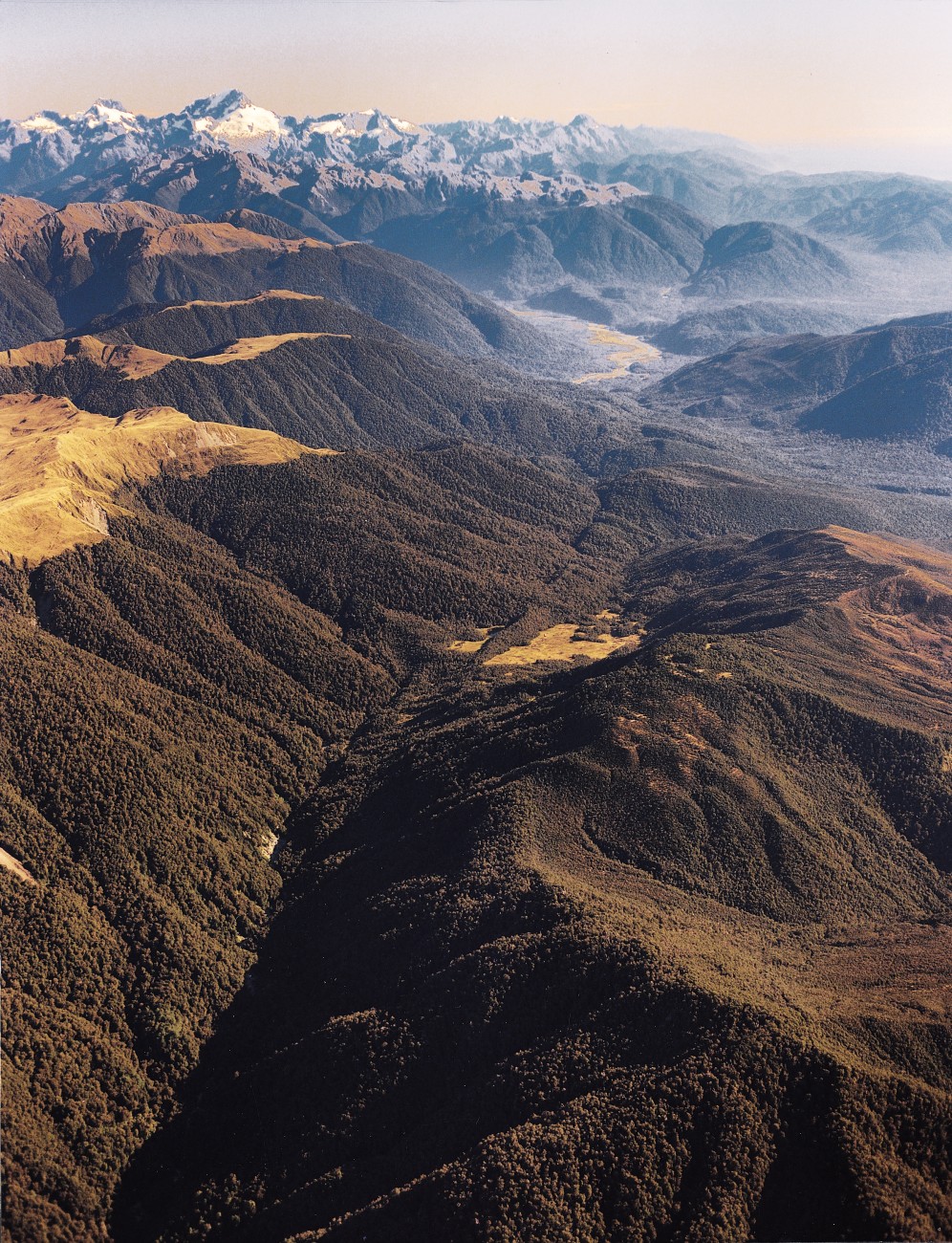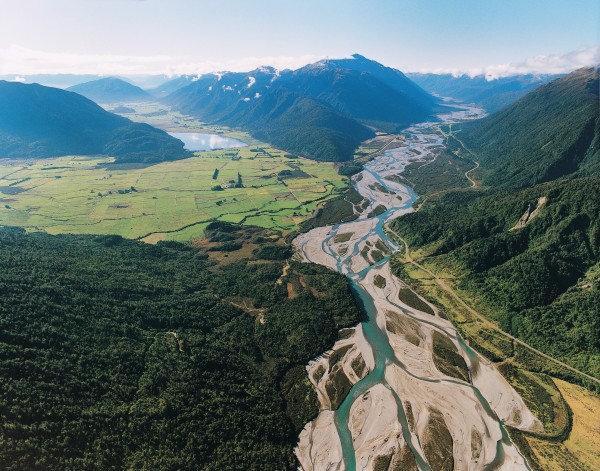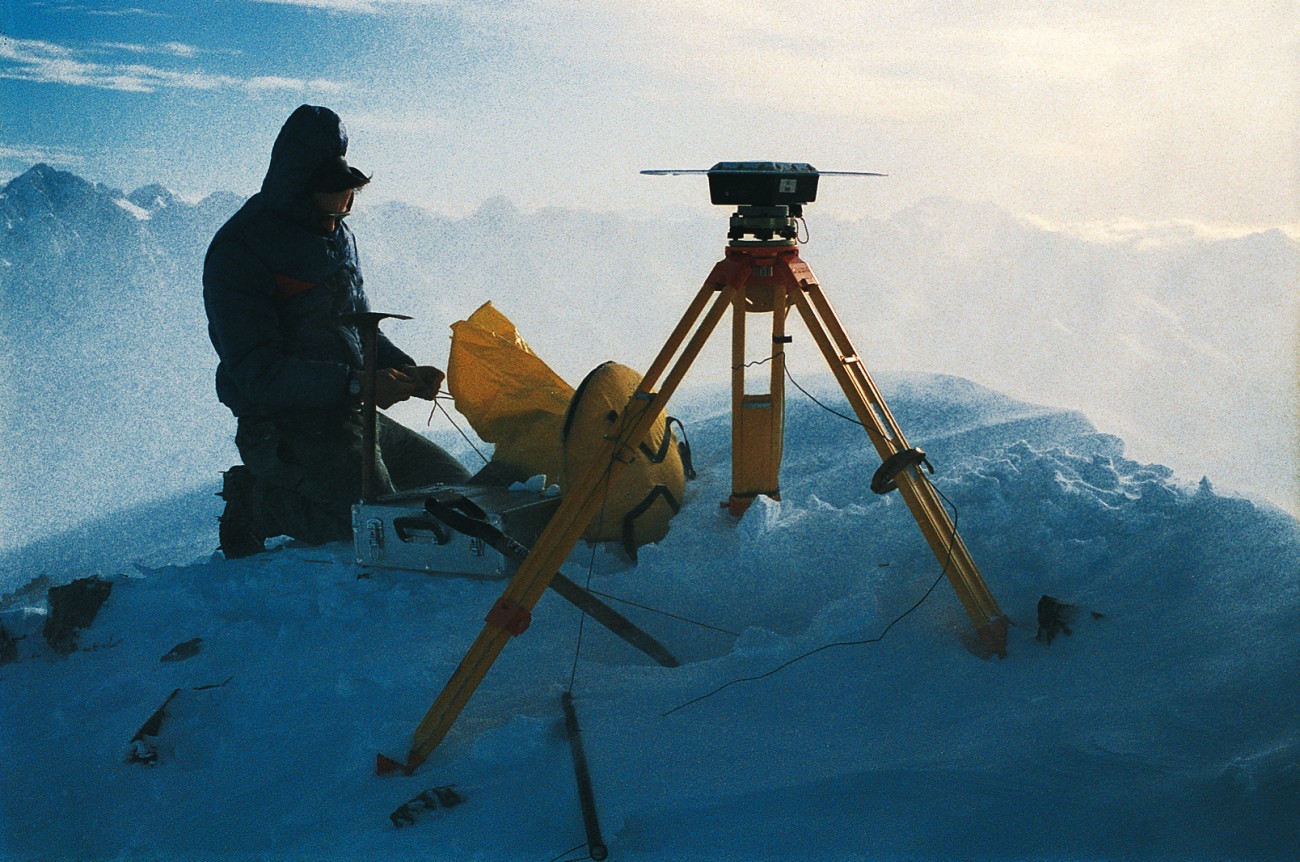
Harold Wellman and the Alpine Fault
Drenching rain, lush forests, rivers that regularly inundate the land, even sandflies and that fierce human independence bred by isolation—all that is the West Coast can be traced ultimately to the towering presence of the Southern Alps. Yet from a geological perspective these mountains are mere outward symptoms of greater things happening beneath the ground, where two of the world’s tectonic plates collide along one of Earth’s greatest fault lines, dubbed the Alpine Fault. Geologists Harold Wellman was the first to recognise this vast structure, a discovery that helped revolutionise the way we see the Earth.
A Large Land, uplifted high, bearing south-east of us,” was how Abel Tasman recorded that first glimpse which Europeans had of New Zealand, on December 13, 1642. Approching from Tasmania, the Dutch explorer encountered the West Coast about the latitude of Punakaiki, before turning north towards his fatal encounter with the Maori of Taitapu (Golden Bay). The line of the towering Southern Alps rising steeply above the narrow coastal strip of the West Coast remains one of the most impressive views in the country.
But why are they “uplifted high”? What pushed up the land to make the great wall of the Southern Alps? Geologists puzzled over this question for a century before one of them went to the same mountains that many others had looked at, but saw what others had missed, and comprehended what they had not dared to believe. Harold Wellman not only recognised one of the most extraordinary geological structures in New Zealand, but his insight into what must have happened there helped set off a revolution in science. It helped change the way we think about the way the Earth works.
Harold Wellman is a geologist with a more varied experience than most.
He first came to New Zealand from Britain in 1927 when he was 18, and soon found steady work as a surveyor’s assistant. In 1932, he obtained his own ticket as a registered surveyor, but in the Depression, work was scarce. He did some work in Napier in the aftermath of the 1931 earthquake, and surveyed the site of a garage at Ninety Mile Beach, to be erected in conjunction with an attempt on the land speed record by one Wizard Smith. The attempt fizzled, and Wellman joined the unemployed.
He drifted south, carrying his swag down the West Coast from Grey-mouth, prospecting for gold as far as Gillespies Beach and the Haast. Along the way, he and a mate learned the trick of washing fine gold from the black sands by trapping it on a woollen blanket in the bottom of a box.
He wandered back up the Coast with money in his pocket, past Greymouth and Buller, on to Karamea and finally Collingwood via the Heaphy Track.

The government of the time wanted to encourage gold prospecting—it provided wealth for the country and work for the unemployed. Thus in 1934 the government Unemployment Board made a large grant to the Department of Scientific and Industrial Research to make geophysical and geological surveys to locate likely gold-bearing deposits as a guide to prospectors.
Wellman, now an experienced and occasionally successful prospector as well as surveyor, wrote to the DSIR for a job and was sent to join the geophysical survey team. For the next few years he worked in this capacity, again mainly on the West Coast. His boss told him he would never get far in the DSIR without a degree, so he also began extramural university studies.
By the end of 1940, he had spent a year working as a geologist in New Guinea, married, completed a masters degree in geology, transferred from the general to the professional staff of DSIR (with a big pay increase), and was on his way as a geologist He was to become something of a maverick, however, never in line for the top jobs, but always full of ideas, and with the physical and mental energy and agility to leave his more pedestrian colleagues several steps behind. But his ideas were always based on extensive fieldwork and merited careful consideration.
In 1958, he moved to Victoria University where his love of debate and scorn for dogma and orthodoxy endeared him to students and offended colleagues. Wellman could be accused of many things, but never of politeness, said a colleague. He was never happier than when debating some geological problem, preferably with a beer in front of him and, in the earlier days, with tobacco in hand. Even in government department days, Wellman was credited with instituting the pub as the main forum for geological debate. At the university he was a willing participant in student parties with their raucous singing, copious quantities of home brew, and outrageous pranks. He is reported to have started a short-lived fad among the students for consuming live garden snails, shells and all. But among the antics and the aggravation, Wellman made respected contributions on a broad range of geological fronts, resulting in his being made a professor and a fellow of the Royal Society of New Zealand and being awarded a DSc degree.
But all this was well in the future when Wellman received his first assignments as a DSIR geologist. These first tasks were mainly to assist the war effort. In 1940, he and another newly graduated geologist, Dick Willett, were sent to search for mica, a strategic mineral needed to make electronic components for radio equipment. They examined a deposit in Fiordland, which proved to have been worked out, and then made several expeditions to check other deposits reported by a prospector in South Westland. They found enough mica to meet New Zealand’s wartime needs, and also took the opportunity to examine an area few geologists had visited before. In particular, they saw that the steep front faces of the mountains they were scouring for mica—Mt Kinnaird to the north of the Moeraki River and the Mataketake Range to the south—were in fact the line of a very large fault.
When they looked more carefully, Wellman and Willett saw further traces of faulting. Movement on a fault commonly crushes and shatters the adjacent rock, which then erodes away more quickly than the surrounding country, often leaving a characteristic linear depression or valley. Wellman and Willett found many signs of such a fault depression. The main road even passed along it in some places.
When they visited the area again in August 1941, the weather was unusually fine and they spent six weeks working their way south, examining the general geology of the country and tracing the line of the fault. At that time the road ended at Paringa, and apart from another isolated stretch of formed road at the settlements of Haast and Jackson Bay 50 km further south, there were only pack tracks. Wellman and Willett took a track south to the Haast River, noting the fault depression along the way.

Beyond Jackson Bay, they followed the fault again up the Jackson River to the Martyr Saddle. They walked as far as Martins Bay, where Dave Gunn ran the country’s most isolated cattle run, then struck inland up the Hollyford Valley to eventually come out on the Te Anau-Milford road. On the way they crossed the fault trace again. It could be seen in the line of Hokuri Creek, and showed as a noticeable notch in the hills heading towards Milford Sound.
Wellman and Willett put together their notes and looked at previous geological records from the area—including a large geological map of Westland drawn many years before by the legendary “Mr Explorer” Douglas (see New Zealand Geographic, Issue 32)
They also looked further afield. Earlier geologists had mapped large faults in several different places along the Southern Alps, but Wellman and Willett now had a wider vision. They considered that these were not separate faults but successive traces of one immense fracture at least 650 km long, cutting right through the South Island from the Fiordland coast to the Nelson Lakes and Marlborough. Adopting a name used earlier for the Nelson segment, they named it the Alpine Fault.
Just a few weeks after emerging from the West Coast bush, Wellman and Willett formally presented their findings to a meeting of the Royal Society of New Zealand in Wellington, phrased in traditional understated scientific fashion: “Attention is drawn to a major fault that extends along the west of the Southern Alps . . . .” The announcement was received with much interest by their fellow geologists. Wellman and Willett’s Alpine Fault was very large, but not beyond belief. Geologists in New Zealand are generally familiar with faults and fault phenomena—they are more common here than in most countries. The Alpine Fault quickly became accepted as a notable feature of the geology of New Zealand, and by 1948 was included on standard geological maps.
[Chapter Break]
After their groundbreaking paper on the Alpine Fault, Willett was posted to Invercargill and Wellman to another wartime project at d’Urville Island. Again he took the opportunity to make a close examination of the general geology of the area. And once again he saw what others had not dared to consider. He gradually realised that there was much more to the Alpine Fault, and the evidence was right there in front of him.
One of the odd things about the geology of d’Urville Island and the Nelson area was that its combination of geological features was repeated in the Otago-Southland region 500 km to the south. No one had paid much attention to this before, but Wellman looked more closely at the similarities. He was now very familiar with the Nelson end from his d’Urville Island work, and in 1947-48 he learned more details of the Otago end from correspondence with his colleagues Larry Harrington (who tramped the Hollyford Valley in his holidays) and George Grindley (who was studying the geology of the Eglinton Valley for his MSc thesis).
Wellman realised that the Nelson and Otago geologies matched very closely indeed. The stratigraphy, or sequence of rock layers, was essentially the same in both areas, and both also had a mineral belt of unusual ultrabasic rocks. These rocks are low in silica but rich in iron and magnesium minerals, and few plants are able to grow on them. The mineral belts in Nelson and Otago each ended abruptly at the Alpine Fault with distinctive mineralised mountains which, coincidentally, were each named “Red Hill” from their striking colour.
But was it just coincidence? Wellman considered the match between the Nelson rocks on one side of the Alpine Fault and the Otago rocks 500 km away on the other. Looking at them on the geological map, Wellman noticed that if Nelson could be slid along the line of the fault to lie beside Otago, the two regions’ geological formations would line up nicely. He concluded that this was exactly what had happened: that the Nelson and Otago rocks had originally been formed as one, but had been cut in two by the Alpine Fault and had been pushed progressively further out of line by a long succession of horizontal movements on the fault, until they were now 500 km apart.
Wellman presented this audacious idea to the DSIR geologists at their annual staff conference in May 1948, and then to an international gathering at the Pacific Science Congress held in Christchurch in February 1949. The scientists didn’t know quite what to make of it. Horizontal or “transcurrent” fault movement was well recognised, and so was the idea of successive movements on the same fault, but not to the extent proposed by Wellman. American geologists had suggested the possibility of up to 40 km of accumulated movement on the San Andreas Fault, and a British geologist had argued for 100 km on the Great Glen fault in Scotland, but even these displacements were still doubted by many scientists. Wellman’s idea went much further, and in the process raised questions about the adequacy of existing theories concerning the forces and movements operating in the Earth’s crust.

Sedimentary rocks—those formed originally from flat, even beds of marine sediment—are often found tilted, uplifted, folded and torn, so it is clear that there must be considerable strains and thrusts in the Earth’s crust to bend and buckle the rocks in this way. For many years the generally accepted explanation for these processes had been the one developed by the Austrian geologist Eduard Suess, that the buckling occurred as the rigid crust adjusted itself to a cooling and shrinking Earth. But what Wellman was proposing hardly fitted this scenario. The Suess model allowed for limited horizontal movements in the crust, but movements of the magnitude suggested by Wellman seemed quite inconceivable.
There was another theory that did allow for large horizontal movements, but it was generally considered crackpot and not worthy of serious scientific consideration. In 1912, a visionary German meteorologist, Alfred Wegener, had proposed his theory of “continental drift” to explain the way the shapes of continents (especially Africa and South America) seemed to fit together like pieces of a jigsaw puzzle, and even mountain ranges could be seen to start on one continent and continue on another. For instance, the Appalachians of the US and Newfoundland could be tied to mountains in Ireland, England and France. Wegener suggested that the present continents had once been joined, but had drifted apart. However, his idea was rejected as fanciful by most geologists because there was no plausible explanation of how such drift might occur. What forces could drive the continents around the face of the Earth? The term “drift” became a term of derision to orthodox geologists.
Wellman’s idea of 500 km of horizontal movement was therefore difficult for his scientific colleagues to accept. Wellman himself didn’t immediately write it up into a formal scientific paper. He was sure of the match between the Nelson and Otago ends, but searched for more evidence of the horizontal movement that might explain it. He looked for other markers of movement—other structures or alignments crossing the fault which would indicate whether it was moving in the way the displacement between the Nelson and Otago geological formations suggested.
With his surveyor’s eye for three-dimensional relationships, Wellman developed a particularly ingenious method using river-shingle flats as markers of movement. In many places in New Zealand there are shingle flats originally formed as glacial outwash during the last ice age some thousands of years ago. Where rivers cut down through such shingle flats they sometimes form a series of progressively lower terraces like a flight of steps. At one of the most accessible parts of the Alpine Fault, where it crosses the Maruia River near Springs Junction on the Lewis Pass road, Wellman found one such flighted terrace which the fault cut across. Horizontal misalignment in the “risers” of the terraces showed how far the fault had moved horizontally since that step had been formed, and vertical misalignment in the terrace surfaces showed how far it had moved vertically. At Maruia there was 10 metres of horizontal movement for every metre of vertical displacement. The whole flight preserved a record of cumulative fault movements during successive periods of terrace formation since the ice age. The exact age of each terrace was not known, but they did confirm for Wellman that there had been continuing movement on the fault since the last glaciation.
Surveyors’ trig points provided a simpler kind of marker, but relating to a much shorter period. Wellman searched old survey records to find the theodolite readings between trig stations on either side of the fault as measured in the 1890s, and compared them with the corresponding measurements between the same trig stations in a new survey done in the 1940s.
[sidebar-1]
The earlier surveys had not been tied together well between Westland and Canterbury along the main part of the Alpine Fault, but there were good measurements spanning its northern branches, the Wairau and Awatere Faults through Marlborough. Here Wellman found consistent shifts in the survey lines over the 50 years between the surveys. Even though there had been no movement on the faults themselves in that time, the wider fault zone was being strained and bent.
All the evidence told the same story: the misalignments in the Maruia shingle flats, the shifts between successive surveys and the 500 km displacement between the matching Nelson and Otago geological formations all showed a mainly horizontal shift—in which the east side of the fault was moving south relative to the west side by the equivalent of a few centimetres per year. It was clear to Wellman that the Alpine Fault had indeed been grinding along in the same direction for millions of years and hundreds of kilometres.
[Chapter Break]
Many New zealand scientists refused to accept Wellman’s idea. He had no mechanism for his hypothesised movements, so they looked for alternative explanations to the Nelson/Otago match. But some overseas scientists greeted Wellman’s views with interest. The famous seismologist Charles Richter, who had heard Wellman’s idea at the Pacific Science Congress in 1949, called it a “bold suggestion.” A pair of American geologists were so inspired by it that they suggested there might also have been hundreds of kilometres of movement on their San Andreas Fault.

But it was difficult to reconcile the evidence of such large-scale horizontal movements with existing theory. As more evidence of anomalies came to light, alternative theories began to be considered. If there could be horizontal movement of 500 km as Wellman was suggesting for the Alpine Fault, then perhaps Wegener’s idea of continental drift was not so outrageous after all.
It all came together in the late 1960s. A number of ideas from oceanography, geophysics, and seismology were combined into a new theory which made sense of many aspects which had not fitted the old theory, including Wellman’s evidence of large-scale horizontal movement on the Alpine Fault. The new theory, known as “plate tectonics,” extended the notion of continental drift and provided what Wegener’s theory had lacked: an explanatory model of how drift occurred.
Plate tectonics is based on the idea that the Earth’s crust is made up of a jigsaw pattern of separate plates which are in continual slow motion, driven by great convection currents in the depths of the Earth. The plate movements operate rather like a conveyor belt. Under the oceans, where the crust is thin, new crust is continually being created by upwelling of molten rock at mid-ocean rifts, which then spreads out in both directions as a rigid plate. At the outer edge of the plate, where it runs up against the adjoining plate, one of them is pushed down or subducted under the other to sink back down into the hotter regions, where it melts again and completes the cycle.
Most of this movement goes on under the sea, hidden from sight. Land areas, which are formed of thicker, lighter “continental” crust, are mainly passive, hitchhiking passengers in the process, and give geologists few signs of what is happening.

Even when continental crust reaches the edge of a plate, and the adjoining plate of thinner, denser “oceanic” crust is pushed down under it, the signs of the collision are not obvious. But in a few places, where two colliding plates both have continental crust at their edges too thick and too light to be pushed under, the results are spectacular. The great pile-up of the Himalayas is one such place. Another, where the plates are colliding at a more oblique angle, is the Alpine Fault.
Especially now that we have the longer view provided by satellite photographs from out in space, we can see the Alpine Fault as one of the clearest marks on the planet of the plates moving within its skin. The South Island lies across the edges of the Australian and Pacific Plates. To the north, the oceanic crust of the Pacific Plate is being pushed down under the continental crust of the North Island from the east, and to the south the oceanic crust of the Australian Plate is being pushed down under the continental crust of Fiordland from the west. In between, continental crust meets continental crust. Westland and Nelson along the edge of the Australian Plate, and the rest of the South Island along the edge of the Pacific Plate, grind against each other, pressing together so hard that the edge of the Pacific Plate is buckled up into the long wall of the Southern Alps and its foothills extending back east across the South Island. The inexorable motion of the plates has made New Zealand a land uplifted high, splintered by faults, and jarred by earthquakes.
[Chapter Break]
Harold Wellman now I in his late 80s, lives quietly in retirement high on fault- uplifted hills overlooking Wellington. He still has the gift of being able to think in three dimensions when most of us struggle with two, and still likes to demonstrate the essential simplicity of his ideas in graphic models. Then I climbed the steps to see him, he patiently explained once more the movement on the Alpine Fault, which had seemed so clear to him but which took others years more to see.
To make it plain to me he took the scissors and cut a geological map of the South Island along the line of the Alpine Fault and showed me how sliding the two sides back along the line of the Alpine Fault brought the geological formations in Nelson and Otago into alignment.
The conclusion that there must have been 500 km of horizontal movement seems obvious now, but it took Wellman’s perspicacity and a revolution in science to make it so.
[sidebar-2]


























